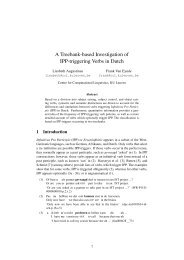Introduction to Linguistics
Introduction to Linguistics
Introduction to Linguistics
Create successful ePaper yourself
Turn your PDF publications into a flip-book with our unique Google optimized e-Paper software.
<strong>Introduction</strong> <strong>to</strong> General <strong>Linguistics</strong> WS12/13 page 2<br />
First reason: if we express just the verb and object, without the rest of the sentence structure<br />
around it, then the basic order is object verb:<br />
(3) A: Hast du eine Lösung für die Klimakrise?<br />
B: Bus fahren, Rad fahren, den Fernseher ausschalten, die Heizung runterdrehen.<br />
B: *fahren Bus, fahren Rad, ausschalten den Fernseher, runterdrehen die Heizung<br />
There is no CP or IP (non-finite verb!) so this is just a VP. It is systematically head-final.<br />
Even small children learn this very early. So the German VP is basically head-final, with its<br />
complement on the left. This is not what we find in Der Vogel frisst den Wurm.<br />
Second reason: Even in declarative main clauses, the basic order of verbs and their<br />
complements is complement>verb. If we only have one verb, we do not see this, but as soon<br />
as we add several verbs we can see that just the first, finite verb shifts forwards: the rest<br />
never do. The finite verb is the exception. The others always appear <strong>to</strong> the right of their<br />
complements. This shows us that the basic order is head-final; the shifted verb is the<br />
exception.<br />
(4) a. Du hast es.<br />
b. Du hast es

















